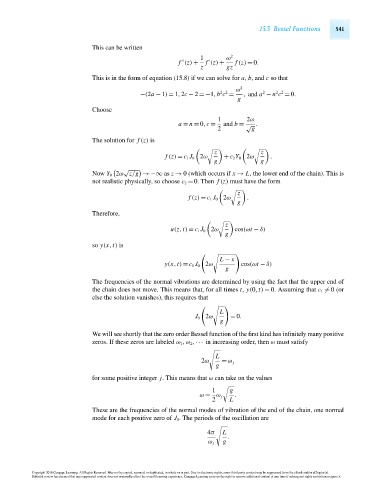Page 561 - Advanced_Engineering_Mathematics o'neil
P. 561
15.3 Bessel Functions 541
This can be written
1 ω 2
f (z) + f (z) + f (z) = 0.
z gz
This is in the form of equation (15.8) if we can solve for a, b, and c so that
ω 2
2 2 2 2 2
−(2a − 1) = 1,2c − 2 =−1,b c = , and a − n c = 0.
g
Choose
1 2ω
a = n = 0,c = and b = √ .
2 g
The solution for f (z) is
z z
f (z) = c 1 J 0 2ω + c 2 Y 0 2ω .
g g
√
Now Y 0 2ω z/g →−∞ as z → 0 (which occurs if x → L, the lower end of the chain). This is
not realistic physically, so choose c 2 = 0. Then f (z) must have the form
z
f (z) = c 1 J 0 2ω .
g
Therefore,
z
u(z,t) = c 1 J 0 2ω cos(ωt − δ)
g
so y(x,t) is
L − x
y(x,t) = c 1 J 0 2ω cos(ωt − δ)
g
The frequencies of the normal vibrations are determined by using the fact that the upper end of
the chain does not move. This means that, for all times t, y(0,t) = 0. Assuming that c 1 = 0(or
else the solution vanishes), this requires that
L
J 0 2ω = 0.
g
We will see shortly that the zero order Bessel function of the first kind has infinitely many positive
zeros. If these zeros are labeled ω 1 , ω 2 , ··· in increasing order, then ω must satisfy
L
2ω = ω j
g
for some positive integer j. This means that ω can take on the values
1 g
ω = ω j .
2 L
These are the frequencies of the normal modes of vibration of the end of the chain, one normal
mode for each positive zero of J 0 . The periods of the oscillation are
4π L
.
g
ω j
Copyright 2010 Cengage Learning. All Rights Reserved. May not be copied, scanned, or duplicated, in whole or in part. Due to electronic rights, some third party content may be suppressed from the eBook and/or eChapter(s).
Editorial review has deemed that any suppressed content does not materially affect the overall learning experience. Cengage Learning reserves the right to remove additional content at any time if subsequent rights restrictions require it.
October 14, 2010 15:20 THM/NEIL Page-541 27410_15_ch15_p505-562

